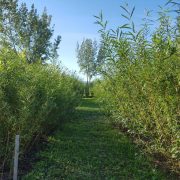Phytoremediation, a phytotechnology with multiple benefits
Phytoremediation is a soft decontamination technique that exploits the natural capacities of plant species, algae (phycoremediation), but also fungi (mycoremediation) to degrade, store or immobilize a wide range of contaminants present in their environment (air, water and soil) [1].
Four phytoremediation techniques are used, depending on the types of contaminants present on the sites to be decontaminated and the plant species selected:
- Phytostabilization
This technique aims to stabilize the trace elements of the soil (metals [Zn, Cd] and metalloids [As]) in and around the root network to reduce their mobility and thus their dispersion in the environment. This strategy does not solve the problem of soil contamination, but it allows to limit its extension while waiting to set up the decontamination phase. It is therefore not a decontamination technique per se, but a site management method designed to immobilize contaminants in the soil. To improve the process, organic or mineral amendments (or immobilizing agents) can be added to limit the bioavailability of trace elements. The most used are phosphate compounds (calcium phosphate, apatite), organic compounds (compost or sludge), clays, ashes and alkalizing products (lime).
- Phytoextraction
It is based on the accumulation of trace elements in the aerial, harvestable parts of the plants, which thus makes it possible to reduce their concentrations in the soil. However, the reduction is only partial, as it only concerns the phyto-available fraction of the contaminants, the fraction of contaminants that the plant species can assimilate. Thus, assisted phytoextraction will allow to optimize the process by adding different amendments when the plant has reached a certain growth stage. These additions will increase extraction yields in two ways: by promoting growth and thus plant biomass, and by making trace elements present in the soil more bioavailable to facilitate their absorption by the plants and their transfer to the aerial parts.
- Phytodegradation
It consists in degrading or transforming organic contaminants by plants which metabolize them in their tissues or outside of them thanks to enzymes that they secrete.
- Rhizodegradation
It is based on the degradation of organic contaminants by soil microorganisms associated with the roots.
The decontamination of contaminated sites by phytoremediation is applicable in urban and rural areas on a wide range of contaminated soils (agricultural land, industrial wastelands, excavated sediments, etc.). In a context of sustainable development, this technique is preferable to conventional methods (soil excavation and off-site treatment) and is becoming increasingly popular in the contaminated site treatment and management markets. Although it is better suited to moderate contamination and presents a constraint relative to the duration of the treatments, phytoremediation offers an ecological, landscape and financial alternative. Indeed, it can contribute to the reconversion of a contaminated site into a green space, enhancing its landscape aesthetics and attractiveness, but can also accommodate educational and social projects, thus facilitating the task of decision makers for the reasoned development of the territory.
For example, since 2016, a project concerning the rehabilitation by phytoremediation of four hectares of contaminated industrial sites has been implemented in the Rivière-des-Prairies-Pointe-aux-Trembles borough[2]. This project aims to test several processes of phytotechnologies and phytogestion to offer the most effective turnkey solutions for the rehabilitation of this type of land.
[1] Greipsson S. (2011). Phytoremediation. Nature Education Knowledge 3 (10), 7.
[2] https://ici.radio-canada.ca/info/videos/media-8510445/pouvoir-decontaminant-plantes?fbclid=IwAR0w7nmPHLo7uUABNoH5xG96lN23r6t1MU3EatnVbqbXbnN1ZkO231k-jnk



